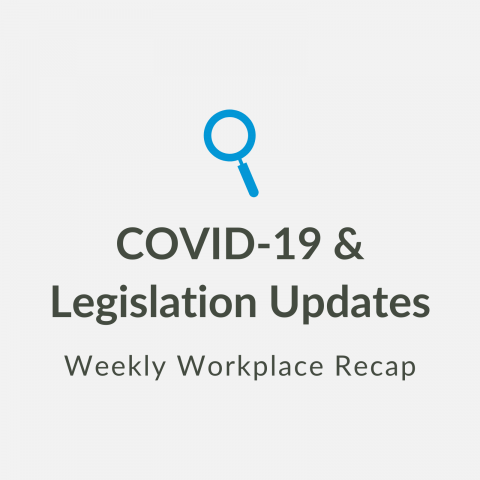COVID-19 & Legislation Updates | Weekly Workplace Recap from June 18 to July 1, 2021

Below are the key announcements from the Federal, Ontario, Alberta and BC governments that touch on workplace legislation from June 18 to July 1, 2021.
Federal
Provides Guidance on COVID-19 Workplace Risk Assessments & Safety Plans
The Canadian Centre for Occupational Health and Safety (CCOHS) has developed a free online course to help Canadian businesses conduct a COVID-19 workplace risk assessment and safety plan.
The COVID-19 Workplace Risk Assessment and Safety Plan course outlines the steps needed to plan and conduct a COVID-19 workplace risk assessment, and to plan and evaluate a workplace safety plan.
The average time to complete the course is approximately 20 minutes. Employers will learn the work and personal factors to consider when assessing and preventing the risk of exposure, reviewing a safety plan to ensure it is effective, and keeping up to date with current COVID-19 guidelines.
COVID-19 Workplace Risk Assessment and Safety Plan is available on the CCOHS website.
Launches Online Calculator to Help Businesses Apply for CPHR
The government of Canada has launched an online calculator to help eligible employers prepare their Canada Recovery Hiring Program (CRHP) applications.
The recently announced CRHP will help hard-hit businesses hire the workers they need to recover and grow as local economies reopen. This calculator integrates the new CRHP with the Canada Emergency Wage Subsidy (CEWS), automatically showing applicants which subsidy will provide them with more support, based on the information they enter.
Eligible employers will be able to apply for the CRHP starting July 7, 2021, when the Canada Revenue Agency (CRA) will open applications through My Business Account and Represent a Client.
For more information, check out this news release.
Ontario
Moves to Step Two of Roadmap to Reopen on June 30
Ontario entered Step 2 of its Roadmap to Reopen on Wednesday, June 30, 2021. The Step Two restrictions are found in O. Reg. 263/20 and include but are not limited to:
- Outdoor social gatherings and organized public events with up to 25 people
- Indoor social gatherings and organized public events with up to 5 people
- Essential and other select retail permitted at 50% capacity
- Non-essential retail permitted at 25% capacity
- Personal care services where face coverings can be worn at all times, and at 25% capacity and other restrictions
- Outdoor dining with up to 6 people per table, with exceptions for larger households and other restrictions
- Indoor religious services, rites, or ceremonies, including wedding services and funeral services permitted at up to 25% capacity of the particular room
- Outdoor concert venues, theatres and cinemas, with spectators permitted at 25% capacity
Please view the regulation for the full list of public health and workplace safety measures that need to be followed.
For more information, check out this news release.
Aims to Streamline Employer OHS Reporting Requirements into a Single Regulation
A new regulation under the Occupational Health and Safety Act (OHSA) will come into effect on July 1, 2021: Ontario Regulation 420 / 21 – Notices and Reports under Sections 51 to 53.1 of the Act – Fatalities, Critical Injuries, Occupational Illnesses and Other Incidents.
The new regulation incorporates the critical injury definition and streamlines reporting requirements into a single regulation that applies to all workplaces covered under the OHSA.
Under section 3 of the Regulation, employers must provide a written report or written notice if:
- a worker is killed or critically injured from any cause at a workplace;
- a worker is disabled from performing his or her usual work or requires medical attention because of an accident, explosion, fire or incident of workplace violent at a workplace, but no person dies or is critically injured because of that event; or
- the employer is advised by or on behalf of a worker that the worker has an occupational illness or that a claim in respect of an occupational illness has been filed with the Workplace Safety and Insurance Board by or on behalf of the worker.
For more information, check out O. Reg. 420/21.
Alberta
Enters Final Stage of Reopening on July 1
Alberta has reached the 70% threshold for Stage 3 of the Open for Summer Plan, which is slated to begin on July 1.
The following relaxed restrictions come into effect on July 1:
-
All restrictions will be lifted, including a ban on all social gatherings indoors.
- Mandatory isolation for confirmed cases of COVID-19 and certain protective measures in long-term care facilities will be maintained.
- Wearing a mask indoors will no longer be mandatory throughout the province, except in certain special circumstances.
For more information on business restrictions, visit Alberta Biz Connect.
British Columbia
Shifts to Step 3 of Restart Plan on July 1
The provincial state of emergency was lifted on June 30 at 11:59 p.m., signaling the end to the longest provincial state of emergency in BC’s history.
As BC moves into Step Three, businesses will gradually transition to new communicable disease plans with guidelines for these plans released by WorkSafeBC on June 28. These plans will continue to include physical barriers at many business and retail settings. Capacity limits, formal health screening tests and directional arrows, as well as other physical distancing measures will no longer be required. However, they may still be used during this transition period.
For more information, check out this news release.


